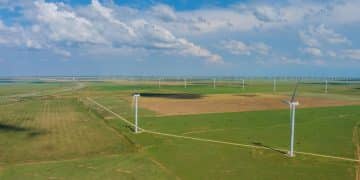Carbon Capture Technology: Solution to US Emissions by 2050?

Carbon capture technology’s viability as a large-scale solution to reducing US emissions by 2050 depends on technological advancements, economic feasibility, policy support, and public acceptance.
Can carbon capture technology: Is it a viable solution for reducing US emissions by 2050? The United States has set ambitious goals for reducing its carbon footprint, raising the pivotal question of how best to achieve these targets.
Understanding Carbon Capture Technology
Carbon capture technology (CCT) is a set of processes designed to prevent carbon dioxide (CO2) emissions from entering the atmosphere. This section explores the basics of CCT, its various forms, and how it can be implemented in different settings.
These technologies aim to play a crucial role in mitigating climate change by capturing CO2 from large point sources, such as power plants and industrial facilities, or directly from the atmosphere.
The Basics of Carbon Capture
Carbon capture involves three primary stages: capturing CO2, transporting it, and storing or utilizing it. The capture stage is the most energy-intensive and costly, often requiring significant modifications to existing infrastructure.
Transportation typically involves pipelines or ships, depending on the location of the capture site and the storage or utilization facility. Storage often occurs deep underground in geological formations, while utilization can involve using CO2 in industrial processes.
Types of Carbon Capture Technologies
There are several types of carbon capture technologies, each suited to different applications. These include pre-combustion capture, post-combustion capture, and oxy-fuel combustion.
Each method has its own advantages and disadvantages, making the choice of technology dependent on the specific context and goals of the project.
- Pre-Combustion Capture: This involves converting fuel into a mixture of hydrogen and CO2 before combustion. The CO2 is then captured before the hydrogen is burned for energy.
- Post-Combustion Capture: This involves capturing CO2 from the flue gas after fuel combustion. It can be retrofitted to existing power plants and industrial facilities.
- Oxy-Fuel Combustion: This involves burning fuel in pure oxygen instead of air, producing a flue gas that is primarily CO2 and water. The CO2 can then be easily captured.
Carbon capture technology presents a promising avenue for mitigating carbon emissions, with various methods tailored to different scenarios. Understanding these technologies is essential for assessing their potential impact on reducing US emissions by 2050.
Current State of Carbon Capture in the US
The current state of carbon capture technology in the US is marked by both progress and challenges. This section provides an overview of existing carbon capture projects, their performance, and the broader landscape of carbon capture deployment across the country.
Despite the growing interest and investment in carbon capture, its widespread adoption faces hurdles related to cost, infrastructure, and regulatory support.

Existing Carbon Capture Projects
Several carbon capture projects are currently operating or under development in the United States. These projects span various industries, including power generation, ethanol production, and natural gas processing.
One notable example is the Petra Nova project in Texas, which captured CO2 from a coal-fired power plant. While Petra Nova faced operational issues and was eventually shut down, it provided valuable lessons for future projects.
Performance and Challenges
The performance of carbon capture projects has been mixed, with some achieving high capture rates and others struggling with technical and economic challenges. The cost of capturing CO2 remains a significant barrier to widespread adoption.
Other challenges include the energy requirements of carbon capture processes and the need for suitable geological storage sites.
- Cost: The high capital and operating costs of carbon capture can make projects economically unviable without government subsidies or incentives.
- Energy Requirements: Carbon capture processes can consume a significant amount of energy, reducing the overall efficiency of power plants and industrial facilities.
- Infrastructure: The lack of sufficient CO2 pipelines and storage sites can limit the deployment of carbon capture technology in certain regions.
The current state of carbon capture in the US reflects a growing interest in mitigating carbon emissions, but also highlights the significant challenges that need to be addressed for widespread deployment.
Economic Feasibility and Investment
Economic feasibility is a critical factor in determining the viability of carbon capture technology as a solution for reducing US emissions by 2050. This section examines the costs associated with carbon capture, potential revenue streams, and the role of government incentives and private investment.
Addressing the economic challenges is essential for unlocking the full potential of carbon capture and enabling its widespread adoption across various industries.
Costs of Carbon Capture
The costs of carbon capture include capital costs for building capture facilities, operating costs for running the facilities, and transportation and storage costs. These costs can vary widely depending on the type of technology used, the location of the project, and the scale of operation.
One way to achieve economic feasibility is through the development of carbon capture hubs and clusters, where multiple facilities can share infrastructure and reduce costs.
Revenue Streams and Market Opportunities
Potential revenue streams for carbon capture projects include the sale of CO2 for enhanced oil recovery (EOR) or other industrial uses, as well as carbon credits and tax incentives. The market for CO2-based products is also growing, creating new opportunities for carbon capture projects.
Examples include using CO2 to create building materials, fertilizers, and other products. However, the scale of these markets is still relatively small compared to the amount of CO2 that needs to be captured to meet emissions reduction targets.
Government Incentives and Private Investment
The role of government incentives and private investment is crucial for driving the deployment of carbon capture technology. Government policies such as tax credits, grants, and loan guarantees can help reduce the financial risks associated with carbon capture projects.
Additionally, private investment from venture capital firms and institutional investors can provide the capital needed to scale up carbon capture technologies and infrastructure.
Economic viability is a key determinant of carbon capture’s future role in US emissions reduction. Strategic investment and policy support are essential to make these projects economically attractive.
Policy and Regulatory Landscape
The policy and regulatory landscape plays a crucial role in shaping the deployment of carbon capture technology in the United States. This section explores the different policies and regulations that support or hinder the development of carbon capture projects, as well as potential future policy changes.
A stable and supportive policy environment is essential for providing the certainty needed to attract investment and scale up carbon capture technologies.
Current Policies and Regulations
Current policies and regulations that support carbon capture in the US include the 45Q tax credit, which provides incentives for capturing and storing CO2. The tax credit has been instrumental in driving investment in carbon capture projects, but its effectiveness has been limited by various factors, such as the complexity of the regulations and the eligibility requirements.
Other relevant policies include state-level initiatives to promote carbon capture and storage, as well as federal research and development programs.
Potential Policy Changes
Potential policy changes that could further support carbon capture include expanding the 45Q tax credit, streamlining the permitting process for carbon capture projects, and establishing clear regulations for CO2 storage.
The creation of carbon capture hubs and clusters could also be facilitated by government policies that encourage collaboration and infrastructure sharing.
Policy and regulatory frameworks will continue to mold the trajectory of carbon capture technology in the US. Supportive policies are crucial for incentivizing investment and deployment.
Technological Advancements and Innovation
Technological advancements and innovation are essential for reducing the costs and improving the efficiency of carbon capture technology. This section explores the latest innovations in carbon capture, as well as potential future breakthroughs.
Continued research and development are needed to make carbon capture more economically viable and environmentally sustainable.
Latest Innovations in Carbon Capture
Recent innovations in carbon capture include the development of new capture materials, such as advanced solvents and membranes, that can more efficiently separate CO2 from flue gas.
Other innovations include the use of artificial intelligence and machine learning to optimize carbon capture processes and reduce energy consumption.

Future Breakthroughs
Future breakthroughs in carbon capture could include the development of direct air capture (DAC) technologies that can remove CO2 directly from the atmosphere. DAC technologies have the potential to play a significant role in achieving net-zero emissions, but they are currently more expensive and energy-intensive than traditional carbon capture technologies.
Other potential breakthroughs include the development of carbon utilization technologies that can convert CO2 into valuable products, such as fuels, chemicals, and building materials.
- Direct Air Capture (DAC): This technology captures CO2 directly from the atmosphere, offering a solution for dispersed emissions sources.
- Advanced Materials: Developing new materials for capture processes can significantly reduce energy consumption and costs.
- Carbon Utilization: Converting captured CO2 into valuable products can create new revenue streams and incentivize carbon capture deployment.
Technological innovation will continue to propel progress in carbon capture, making it more efficient and cost-effective. These advancements are vital for its widespread adoption.
Public Perception and Acceptance
Public perception and acceptance are critical factors in determining the success of carbon capture technology as a solution for reducing US emissions by 2050. This section explores the public’s views on carbon capture, potential concerns, and strategies for building support.
Without public acceptance, even the most technologically advanced and economically viable carbon capture projects may face opposition and delays.
Public Views on Carbon Capture
Public views on carbon capture are often mixed, with some people supporting it as a way to reduce emissions and others raising concerns about its potential impacts on the environment and public health.
A common concern is the potential for CO2 leaks from storage sites, which could pose risks to groundwater and nearby communities. Another concern is the potential for carbon capture projects to prolong the use of fossil fuels, rather than transitioning to renewable energy sources.
Addressing Concerns and Building Support
Strategies for addressing concerns and building support for carbon capture include providing transparent information about the technology, engaging with communities to address their concerns, and ensuring that projects are developed in a safe and sustainable manner.
It is also important to emphasize the potential benefits of carbon capture, such as creating jobs and reducing air pollution.
Gaining public trust and support is crucial for realizing the full potential of carbon capture technology. Transparent communication and community engagement are essential.
| Key Aspect | Brief Description |
|---|---|
| 🏭 Carbon Capture | Technologies that prevent CO2 emissions from entering the atmosphere. |
| 💰 Economic Feasibility | High costs remain a challenge, but government incentives and private investment can help. |
| 📜 Policy Support | Policies like the 45Q tax credit are crucial for driving carbon capture deployment. |
| 🌱 Public Acceptance | Addressing concerns and building public support are essential for project success. |
Frequently Asked Questions
▼
Carbon capture technology refers to a suite of technologies designed to prevent carbon dioxide (CO2) emissions from entering the atmosphere, capturing CO2 from large point sources such as power plants and industrial facilities or directly from the atmosphere.
▼
The technology involves three main stages: capturing CO2 from emission sources, transporting it via pipelines or ships, and storing it underground in geological formations or utilizing it in industrial processes.
▼
The main challenges include the high costs associated with capture and storage, energy requirements of the capture processes, the need for suitable geological storage sites, and public perception and acceptance.
▼
Government policies, such as tax credits (like the 45Q tax credit in the US), grants, and streamlined permitting processes, play a crucial role in incentivizing and supporting the deployment of carbon capture technologies.
▼
Public perception is mixed, with some supporting it as a way to reduce emissions and others raising concerns about its environmental and health impacts. Addressing these concerns through transparent information helps.
Conclusion
In conclusion, while carbon capture technology holds promise as a vital tool in mitigating US emissions by 2050, its widespread implementation faces technological, economic, and social challenges. Continued innovation, supportive policies, and public engagement are necessary to unlock its full potential and contribute to a sustainable future.





